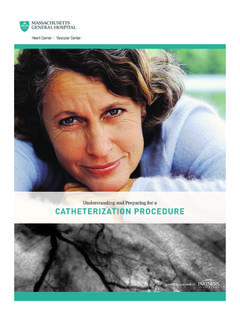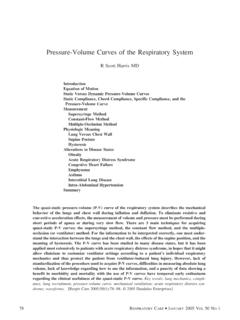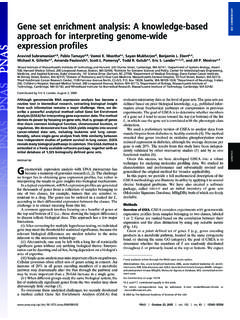Transcription of Combined Melanocytic Nevi: Histologic Variants and ...
1 Combined Melanocytic Nevi: Histologic Variantsand Melanoma MimicsJohanna L. Baran, MD and Lyn M. Duncan, MDAbstract: Combined Melanocytic nevi are composed of 2 ormore distinct populations of nevomelanocytes. Most commonlyused to describe the combination of blue nevi with commonnevi, it may also be applied to other combinations of benignmelanocytic proliferations, including Spitz nevi and nevi withdeep dermal pigmented nevomelanocytes. We report theincidence and distribution of these tumors at the MassachusettsGeneral Hospital over the past decade and review guidelines fordiagnostic criteria and nomenclature. Between 2000 and 2010 weidentified 511 cases of Combined nevi, represented by 4 histo-logically distinct diagnostic categories: (1) blue nevus, (2) neviwith deep dermal pigmented nevomelanocytes (plexiform/deeppenetrating, inverted type A/clonal), (3) Spitz or pigmentedspindled cell nevus, Combined with another type of nevus(usually common or dysplastic), and (4) other combinationsincluding 2 or more nevus types.
2 Nearly one fifth of thesetumors displayed atypical features; atypia was observed moreoften in Combined nevi with Spitz or deep pigmented elements(26 of 55, 47%, and 25 of 98, 26%, respectively) than incombined common and blue nevi (37 of 336, 11%). Clinicalfollow-up data were available for 83% of the patients withatypical Combined nevi; none developed recurrence or metastasiswith a mean follow-up of over 4 Words: Combined nevi, melanoma, clonal nevus, invertedtype A, blue nevus(Am J Surg Pathol2011;35:1540 1548) Combined nevi are neoplasms composed of 2 or moredistinct Melanocytic populations. They comprise anymelanocytic nevus, including blue nevus, Spitz nevus, ornevus with deep dermal pigmented cells, Combined withanother type of nevus, most often common acquired junc-tional, compound, dermal, congenital, lentiginous junctionaldysplastic, or lentiginous compound dysplastic concept of Combined nevus was first discussedin the French literature in first reported caseof a common acquired nevus in combination with a bluenevus was described in 191210but was not described in theEnglish literature until 1962, Lund and Kraus20described the admixture of a blue nevus with an ordinarypigmented nevus as the true and the blue.
3 The specificterm Combined nevus, in reference to a melanocyticnevus with 2 morphologic populations, was coined in1967 by Leopold and ,18 Kernen and Ackerman16identified a separate intradermal nevus component inSpitz nevi, and later Weedon and Little29observed thiscombination in 32 of 211 spindled and epithelioid cellnevi also known as Spitz nevi. In 1977, Gartman andMuller13described in German patients Combined nevithat displayed features of 2 or more of the following typesof nevi: common nevus, blue nevus, cellular blue nevus, orSpitz nevus. In 1981, Fletcher and Sagebiel12reported50 cases of Combined nevi, and in 1985 Rogers et al25described a series of 22 Combined Spitz nevi with a small cellnevic component. In 1991, Pulitzer et al24reported 95 cases,15% of which had features ofmelanocytic dysplasia.
4 In2004, Scolyer et al26produced the largest series (182 cases),describing Combined nevi as any combination of commonand blue or Spitz nevus. In this series, deep penetrating nevuswas considered as a type of bluenevus. In contrast, inves-tigators have identified mutations in GNAQ in 83% of bluenevi (n = 29), without detection of these mutations in deeppenetrating nevi (n = 16).28 This finding may lead one toquestion whether deep penetrating nevi are blue nevusvariants. In terms of site distribution, Combined blue nevihave been described in the skin, oral mucosa,11and addition to combinations of common nevi witheither a blue or Spitz nevic component, Combined nevi havebeen described to include other uncommon nevi includingclonal nevi (also known as inverted type A nevus),23atypical dermal nodule in benign Melanocytic nevus,6melanocytic nevus with a focal atypical epithelioid cellcomponent,3or deep penetrating (plexiform spindle cell)nevus,7all of which describe areas of dermal pigmentednevomelanocytes.
5 This variability in types and in verna-cular has led some to encourage the use of the term Combined nevi/ Melanocytic nevi with phenotypic hetero-geneity with the use of a descriptive term maturation is used to describe cytologicdistinctions of nevomelanocytes in the superficial dermiswhen compared with the deeper dermal the Massachusetts General Hospital, Harvard Medical School,Boston, of Interest and Source of Funding: The authors have disclosedthat they have no significant relationships with, or financial interestin, any commercial companies pertaining to this article. This articlewas not supported by pharmaceutical, industry, or any otherorganization : Lyn M. Duncan, MD, Dermatopathology Unit WRN825, Massachusetts General Hospital, 55 Fruit Street, Boston, MA02114 (e-mail: by Lippincott Williams & WilkinsORIGINALARTICLE1540| J Surg Pathol Volume 35, Number 10, October 2011 Superficially, pigmented epithelioid type A cells are ob-served.)
6 Slightly deeper are type B cells with smaller nuclei,less cytoplasm, and less pigmentation. Finally, at thedeepest aspect of the nevus are type C cells with smallround or fusiform nuclei and scant cytoplasm. Thiscytologic nevomelanocytic gradient in the dermis ischaracteristic of benign nevi. Combined nevi may appearto lack maturation because of the presence of 2 distinctpopulations of dermal nevomelanocytes. Cytologic aty-pia, mitoses, and foci of heavy pigmentation may also ,24 Although Combined nevi appear unusual, whenthe distinct subtypes of nevomelanocytes are recognizedas such, they can be recognized as entirely benign. Theterm atypia is used when these Melanocytic proliferationsdisplay features that may be observed in , cytologic atypia is manifested by thickenednuclear membranes, clumped andasymmetrically dispersednuclear chromatin, prominent nucleoli, and nuclearpleomorphism.
7 In addition, the presence of mitotic activityis atypical in these tumors. The pattern of growth,including low-level epidermal pagetoid spread and anasymmetrical dermal silhouette at scanning magnificationmay also be considered to be atypical features in thissetting. If unaware of the cytologic and architecturalvariation that may be found in these nevi, these char-acteristics may lead to overinterpretation and to theimproper diagnosis of melanoma. Such a misdiagnosis islikely to prompt sentinel lymph node biopsy given thedepth of these tumors. A familiarity with the diagnosticfindings in Combined nevi is critical to the optimalpractice of AND METHODSThe electronic records of the Dermatopathology Unitin the James Homer Wright Laboratories of Pathology atthe Massachusetts General Hospital were reviewed for casesthat included both the terms Combined and nevus inthe final diagnosis field, between January 1, 2000 andJanuary 1, 2010.
8 A total of 540 cases were identified. Casesthat represented a combination of a Melanocytic nevus andan epithelial neoplasm were excluded. Overall, 511 cases ofcombined nevi composed of 2 or more distinct populationsof nevomelanocytes have been diagnosed at the Massachu-setts General Hospital (MGH) over the past decade. Reviewof reports and glass slides led to the identification of 4distinct categories of tumors. The presence or absence anddegree of atypical features were evaluated. Clinical follow-up information was obtained through the electronic medicalrecord for patients with atypical Combined nevi. This studywas approved by the Partners Healthcare InstitutionalReview Board (2010P002328).RESULTSWe identified 511 cases of Combined nevi, includ-ing 59 consultations on slides from other institutions and452 cases processed in the MGH Pathology Laboratory(Table 1).
9 Review of the cases revealed 4 histologicallydistinct diagnostic categories: (1) blue nevus, (2) nevuswith deeply pigmented elements (inverted type A/clonal,deep penetrating/plexiform), or (3) Spitz or pigmentedspindled cell nevus, Combined with another distinct typeof nevus (usually common or dysplastic), or (4) othercombinations including combinations of 3 nevus most common type of Combined nevus in thiscohort was that Combined with blue nevus; 66% of cases(336 of 511) received this diagnosis (Table 1). Of these, 26were consult cases (8%). The patients ranged from 4 to 86years of age (mean, 47 y) and included slightly morefemale than male patients (179 F:158 M). Atypicalfeatures, such as cytologic atypia and mitotic activity,were identified in 11% (37 of 336) of cases.
10 Thirty of the37 patients with atypical nevi (81%) had available clinicalTABLE of Combined Nevi Diagnosed at the MGH 2000 to 2010 DiagnosisAll CasesInside CasesConsult CasesAge (Mean)SexTissue SiteCombined common and blue336310264-86 (47)179 F158 MHead and neck n = 79 (24%)Trunk n = 135 (40%)Extremities n = 99 (29%)Genital n = 1 (<1%)Eye n = 19 (6%) Combined common anddeep pigmented9882134-79 (40)58 F33 MHead and neck n = 34 (35%)Trunk n = 35 (36%)Extremities n = 28 (29%)Genital n = 0 (0%)Eye n = 1 (1%) Combined commonand Spitz554257-76 (35)34 F21 MHead and neck n = 5 (9%)Trunk n = 34 (62%)Extremities n = 14 (25%)Genital n = 0 (0%)Eye n = 1 (2%)Other combination2218413-73 (39)12 F10 MHead and neck n = 3 (13%)Trunk n = 10 (45%)Extremities n = 7 (32%)Genital n = 2 (9%)Eye n = 0 (0%)Am J Surg Pathol Volume 35, Number 10, October 2011 Combined Melanocytic Nevir2011 Lippincott Williams & |1541follow-up data; none experienced recurrence or meta-stasis, with follow-up intervals ranging from 2 to 122months (mean, 58 mo; median, 65 mo) (Table 2).








